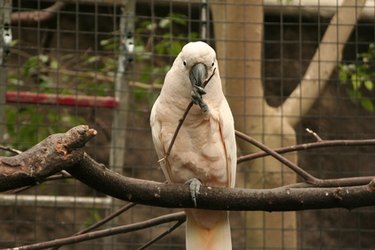Different birds have special needs when it comes to caging. Some birds, like canaries and finches, need cages that re long rather than tall. Other birds, like most parrots, need large cages that can hold lots of toys while still allowing the bird to spread its wings. You might want to soundproof the bird cage if your bird is loud.

Video of the Day
The general rule of thumb is that bigger is always better. You can find many metal, plastic, and wooden bird cages for sale, but the best — and most fun — way to make sure that your pet bird get the biggest cage that will fit in your house is to build it yourself.
Video of the Day
Decide on your size
Determine the size you would like your cage to be. Take into account the size of the bird. A large cage for a sun conure is not a large cage for a macaw. Take into consideration the area where you will put the cage. Make sure you can easily get around three sides of the cage to help with feeding and cleaning. If you plan to hang a large bird cage outdoors, make sure critters can't climb onto and try to get into the cage.
Prepare and attach your lumber
Measure and cut your untreated lumber to size. Cut four pieces for the width and four pieces for the height. For larger birds that like to chew wood, either cover the wood with metal sheeting or replace it with PVC pipe. Nail or screw the lumber together to form a cube. Nails are easier to drive, but screws will keep lumber together better — it's harder for screws to come out than nails.
Pick the side that you would like to be the door. Measure the inside of the frame. Cut another four pieces of wood and nail them together so the new frame fits inside the larger one. Secure the door frame to the cube frame with hinges so the door opens out.
Attach the wire
Make sure the wire mesh is suitable for the size of the bird. The wire should be thick enough so that the bird cannot chew through it. Make sure that the spacing of the wire mesh doesn't allow a bird's head, feet or beak to get stuck.
Use wire cutters to cut the wire mesh into panels the size of each side of the cube. Secure the mesh to the outside of the frame with staples. Very large cages may require additional bracing along the frame to keep the wire mesh from rippling.
Look for sharp edges that might cut your bird if she gets to close or presses against it. Gently pull the wire away from the frame after you're done attaching it to see if you've missed any spots, creating gaps.
Finish the details
Cut 2-inch blocks of lumber, four or six of them depending on how big your cage is, to be used as feet and attach them with nails along the bottom of the cage. If you don't want the cage to scratch your floor, table or other surface, put a non-skid, non-scratch material on the bottom of the feet.
Install a slide lock on the door frame to keep the door closed. Place the cage on top of a tray or tarp to keep the bird's mess from landing on the floor, and consider adding a homemade seed catcher. Add your bird feeder and watering device. Make sure you can quickly and easily get your hand and/or part of your arm into the cage each time you want to add food, change the water or clean the bottom of the cage.
Be careful of painting or staining the wood you use to make the cage. The bird might peck at or chew on the wood and ingest possibly toxic paint or stain.